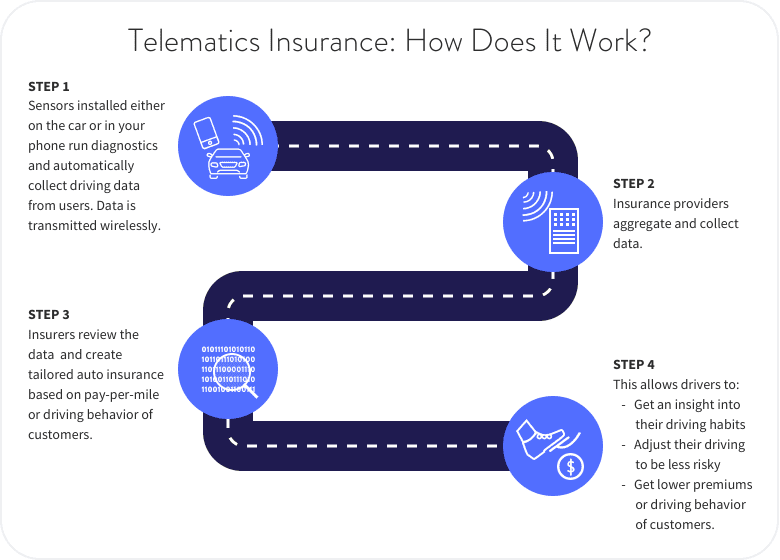Telematics insurance, or usage-based insurance (UBI), is a type of auto insurance wherein an individual’s premium is determined by either one of two things: mileage or behavior. Mileage-based insurance calculates rates according to how much an individual drives their car. On the other hand, behavior-based insurance determines rates based on driving habits. Both models use in-car monitoring devices that use the data collected to calculate premiums.
Telematics Insurance: Usage-Based Auto Coverage
Telematics insurance uses your driving data, be it your mileage or driving behavior, to increase or decrease your monthly premiums.
Updated: October 3, 2024
Advertising & Editorial Disclosure
What Is Telematics Insurance?

Key Takeaways
Telematics car insurance provides insurers with a new way to determine premiums.

Mileage-based insurance charges you based on how many miles you drive, which is best for retirees, city residents who use public transportation and drivers who work from home or don’t often commute for other reasons.
Behavior-based insurance charges you based on your habits on the road, good or bad, which include braking too hard or using your phone while driving.
Individuals can use a black box, plug-and-drive tool or a mobile app to gather data that tells providers about mileage or behavior.
Telematics Insurance: How It Works
Telematics insurance uses monitoring devices such as a mobile app, plugin device or an in-car monitoring unit to gather data on your mileage or driving behavior, which insurers then use to calculate rates.
In particular, mileage-based insurance, known as pay-per-mile insurance, will charge you based on how many miles you drive. On the other hand, behavior-based insurance gathers data to track your driving behavior and rewards you with discounts if you drive safely. Review more about each program below.

Pay-per-Mile
Pay-per-mile insurance bases your premiums on how much you drive. This is best for low-mileage drivers or those who infrequently drive, such as those who own a car but work from home and only use it for occasional errands.
With pay-per-mile insurance, providers will calculate your base rate and rate per mile, which still depend on traditional factors such as age, location, driving history and other details. After calculation, you will be given a device or tool that helps collect driving-related data, which can come in the form of a mobile app or an in-car device. As you use your car, the data will be transmitted to the insurer, who will apply your per-mile rate to your base premium.
It’s worth noting that pay-per-mile insurance is not available in all states — but in those that are, some of the most affordable pay-per-mile insurers include Nationwide, MetroMile, Allstate and Liberty Mutual.
Additionally, based on MoneyGeek’s calculation, pay-per-mile is only more affordable than traditional policies if you travel less than 26 miles per week. If you drive more than this, it might not be your best option.
Behavior-Based
With behavior-based insurance, providers increase or decrease your premiums based on how well you drive. For instance, they can use an in-car device and/or mobile device to determine certain behaviors, such as whether you:
- Drive on weekends, at night or during inclement weather
- Brake or accelerate quickly
- Use your phone
- Speed
Other behaviors may be examined, which can vary depending on the insurer. Behavior-based insurance benefits those with an impeccable driving record, granting them more discounts that lower their premiums.
Fortunately, most insurers offer behavior-based auto insurance programs, depending on where you live. Some of the top insurers that do offer this service include Root, Progressive, GEICO, State Farm, Allstate and more.
Forms of Telematics Tracking
Telematics devices for vehicles can vary based on the insurer. For instance, some providers may use a plug-and-drive tool, while others may opt to use a smartphone app. Review some of the most popular telematics tools for vehicles used by insurers below.
Black Box
A black box, also known as a telematics box, is a small device attached to your vehicle's dashboard. Your insurance company receives data about your driving dynamics via GPS. Black boxes are typically part of your insurance premium, but there may be an added cost if you decide to change vehicles.
Plug-and-Drive
Similar to a black box, a plug-and-drive device uses a GPS to provide data. However, instead of being placed on the dashboard, it can be simply plugged into your car’s USB port, 12V adapter or OBD socket. This allows you to easily transfer the device if you change vehicles. However, keep in mind that your insurer will still need to know if you switch cars as it may play a role in your premium.
Smartphone App
A smartphone app is one of the most convenient tools providers use, as it will not require any installation in your vehicle. Most apps will power on automatically, collecting data once you’re on the road and sending it to the provider via WiFi or GPS. However, as most individuals take their phones wherever they go, it’s important to turn off the tracking app once done driving to avoid accidentally accumulating more miles.
Behavior- and mileage-based insurance types use your data through various channels to reward or penalize your usage. Through the collected data, insurers can decrease or increase premiums, sometimes saving you more money in the long run.
Generally, mileage-based insurance is only suitable for those who rarely drive. In contrast, behavior-based insurance is best for those with clean records and safe driving habits. A traditional policy may be better for you if you drive to and from work daily or have a violation on your record.
Knowing how much car insurance you need is essential before applying for any insurance, whether a telematics insurance policy or a traditional one. Generally, having comprehensive and collision insurance along with 100/300/100 in liability is the best coverage for most drivers. More coverage is recommended depending on age, location, vehicle, etc.

Privacy Concerns Regarding Telematics
Gathering data on your driving is the key to insurers granting discounts based on mileage and behavior, but it also raises privacy concerns. Since providers use tools to get your data and transmit this information wirelessly to their servers, it opens a doorway for all sorts of use. After all, black boxes and mobile apps can tell insurers where you go, what time you went there and for how long. It can even determine who is behind the wheel if there’s voice recognition.
While these can also help with civil actions, such as divorce, and criminal cases like thievery, insurers’ access to this data may make some feel less secure. As such, it’s important to opt for providers who are completely transparent about what type of data they collect and when they collect it. In some states, insurers must disclose how data is collected and used from telematics devices, but in states where this is not a requirement, you may want to ask your provider for more information to protect your privacy.
Telematics: Benefits and Drawbacks
Telematics-based insurance can sound like an advantage for some drivers, but just like any insurance, it has its drawbacks. Review some of the pros and cons below to see if behavior- or mileage-based insurance is the right fit for you.
Benefits and Drawbacks
- It offers more accurately-priced premiums as it is directly based on mileage or behavior.
- It can allow drivers to control their premiums, as less driving or better behavior leads to reduced rates.
- It encourages better driving and fewer people on the road, which promotes a healthier environment and society.
- It can provide data that helps insurers better estimate the cost of damages in case of a claim.
- It can give insight into an individual’s overall driving habits.
- It is not beneficial for those who have poor driving records.
- It can increase premiums significantly if an accident occurs.
- Premiums are not a fixed rate each month, which can make budgeting difficult.
- If a mobile app is used, it may require frequent disputing of driving data. Apps cannot always accurately detect who is driving.
For some, telematics-based auto insurance is a great way to go. That's not the case for every individual. Find the right auto insurance for you by browsing through our guides on the best auto insurance based on driver profile, driving history and more. Whether you need an affordable policy, excellent customer service or want to know what’s available in your area, MoneyGeek has a guide for you.
Telematics Insurance FAQ
Using telematics to determine auto insurance rates may not be a known concept for everyone. If you still have questions, MoneyGeek answered some commonly asked questions below.
For telematics insurance to work, insurers must gather data on your driving. This can be done through a black box or mobile app. As you drive, the tool will collect and transmit data to your insurer, be it data about how many miles you’ve driven or how you drive, which they will then use to calculate your monthly rates.
Telematics is a term used to describe the transmission of data collected from remote objects. This includes cars or even whole fleets. Insurers use telematics to reward drivers who drive less or drive safely with reduced auto insurance premiums.
Telematics insurance can reward infrequent drivers and those with good driving habits for their usage with lower premiums. For instance, mileage-based insurance only charges drivers based on how many miles they drive, while behavior-based insurance grants discounts if a driver is found to practice safe driving skills. Insurance providers gather that these drivers will file fewer claims and be less of a risk on the road.
Related Content
Review some of MoneyGeek’s other guides in the car insurance space below.
- Is Pay-per-Mile Car Insurance Worth It? The Best Options: Learn more about pay-per-mile insurance and whether or not it’s worth it.
- Best Cheap Low-Mileage Car Insurance Companies: If you don’t often drive and want to save on insurance, review MoneyGeek’s guide on auto insurance companies that offer low-mileage insurance.
- How to Get Car Insurance if You Can't Afford It: If you’re interested in telematics insurance because traditional insurance is out of your price range or you’re trying to save, read our guide to find out if there are cheaper options for you.
- The Cheapest Car Insurance Companies: Discover some of the most affordable auto insurance options across the country — and find out which provider offers the cheapest in your state.
- Fears About Safe Driver Programs: Drivers are open to adopting telematics for savings, yet its adoption is still lagging behind expectations. What is holding Telematics Insurance back?
About Nathan Paulus

Nathan Paulus is the Head of Content Marketing at MoneyGeek, with nearly 10 years of experience researching and creating content related to personal finance and financial literacy.
Paulus has a bachelor's degree in English from the University of St. Thomas, Houston. He enjoys helping people from all walks of life build stronger financial foundations.













